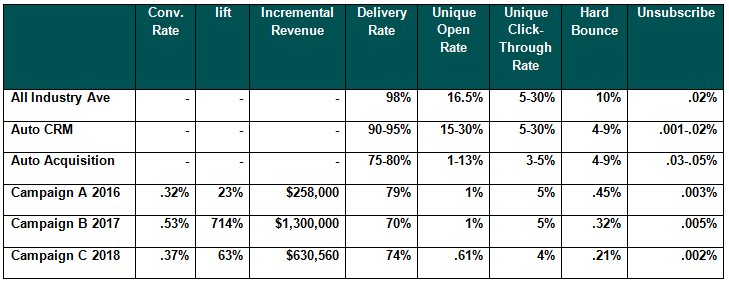Email Marketing Metrics
Originally posted on https://boulevarddm.com/email-marketing-metrics/
Have you ever been asked to compare your email marketing metrics from a campaign to “Industry Standards”?
Client’s want to know about deliverability, open rates, click-through rates. If your numbers are not better than those ‘industry standards’, should your campaign be deemed a failure? Surely, these are key metrics that may be leading indicators to success, but not always. At the end of the day, if the email campaign generates incremental revenue you would not have had if you did not perform the campaign, and that revenue is greater than the cost of the campaign effort, you have a positive financial return. You made money, and nobody should really care about a slightly lower open rate compared to ‘industry standards’.
Debunking Email Marketing Metric Industry Standards
Comparing any given email campaign performance to industry standards is extremely difficult to do. We simply do not recommend this approach as an accurate measure of performance.
At BLVD we pride ourselves on providing clients with Improved Marketing Outcomes that focus toward Return On Investment (ROI).
Our focus is to measure email campaign performance based on whether incremental revenue is generated. Did the campaign we are measuring generate incremental profitable sales to your business? Did those sales more than cover the cost of the campaign? Is your return greater than what you would have achieved had you put the money in the bank? If the answer is yes, the campaign was worth doing and successful.
Knowing that the open rate was a little less than the last campaign is helpfull with the overall strategy and messaging, but it is not always an indicator for ultimate success.
Any comparison to past campaigns, or trying to establish an industry average is also always going to be subject to discrepancies.
Why There Really Is No Standard
We do a lot of work in the automotive industry, so here are some common factors that make automotive industry email campaign performance standards impractical for comparison purposes:
- Models change and refresh within a brand and competitive brands each year, which change consumer consideration and market dynamics
- No two luxury brands have the exact same model/segment line-up or consumer perception
- Outside economic conditions change:
- Interest rates fluctuate
- Employment rates change
- International trade can affect prices
- Weather and natural disasters in markets, depending on timing can increase and/or decrease sales
- Gas prices directly correlate with sales activity and model consideration
- The inventory of new vs. used vehicles affects prices and consumer buying patterns
We could go on. When you consider all these factors, it is easy to dismiss any notion of industry-standard email marketing metrics given all these outside influences.
Additional Email Campaign Differences
- Lists – Data sources change, and there can be big performance differences depending on a list’s mix of current customers, past customers, and pure prospect records. Additionally, vendor differences in the definitions of these record classifications can vary for acquisition and CRM campaign efforts.)
- Offer – The offers from year to year are not always the same, or for the same models
- Creative – The creative message changes from campaign to campaign
Our opinion is that there can be no industry standard in email campaign performance. If the campaign we are measuring generates incremental profitable sales, then it is a success.
Use past campaign ROIs as a benchmark, and then test and adjust in subsequent campaigns to continually attempt improvements in ROI. Keeping in mind that outside economic conditions can still affect this internal profit benchmark approach.
Also, some digital industry standards for email are applied and considered as POTENTIAL indicators for improved ROI. These metrics are optimized to increase the likelihood for improved ROI, but can still be misleading.
Example Email Campaign Performance
These are some real results that help to illustrate our position.

This table shows how industry standards do not always help. Delivery suffered in 2017 compared to 2016, yet 2017’s conversion rate was higher. 2018 delivered better than 2017 and had a lower conversion rate. However, both 2017 and 2018 generated incremental sales revenue that provided a positive ROI.
